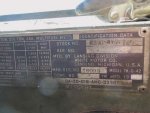TRAILER vs. SEMI-TRAILER
Technically speaking, a TRAILER is a towed vehicle which bears MOST of its own weight and the weight of its LOAD on it's own load-bearing axles. IE: a load "balanced" on one or more axles "centered" under the carriage - OR - as with M989 type Ammunition Trailers, an arrangement of axles usually featuring trailing axles near the rear of the trailer's chassis as well as "steering-type-axles" near the front of the chassis often directionally controlled by the trailer's orientation to the motive vehicle (towing vehicle). ONLY a relatively small "TONGUE WEIGHT" is carried by the tow vehicle when a TRAILER is hitched to it.
WHEREAS, a SEMI-TRAILER is a towed vehicle whose load is substantially borne by the towing vehicle - a Semi-Tractor - typically upon a "Fifth-Wheel & King Pin" hitching and pivoting mechanical linkage.
HENCE, inherently, a SEMI-TRAILER will apply a traction enhancing LOAD upon the TRACTOR's drive axles, while the TRAILER adds only its tongue weight to the towing vehicle.
With regards to STEERING a trailer or semi-trailer....
A SEMI-TRAILER with a portion of its weight upon the TRACTOR's Fifth Wheel will "naturally" track behind the line of travel;
BUT a force must be applied to a TRAILER through it's tongue to the "balanced" load on its axles in order to overcome the straight-line inertial motion of the moving trailer in order to change its course in a turn.
SIMILARLY, the balanced load arrangement on a TRAILER will inherently allow it to "rock n roll" back there and assert "counter-steering forces upon the tail end of the towing vehicle.
I hope this helps to understand the difference in towing designs and why the military so often favors full TRAILER configurations over SEMI-TRAILERs, particularly in OFF-ROAD combinations.
Towing another vehicle on a TOW BAR (ie: when I towed the 5-ton tractor with our deuce) is, by the load bearing theory much like a TRAILER with minimal load on the towing vehicle, it is also "WORSE THAN" a bumper-pulled trailer in that there is no mechanical application of steering forces by the tow vehicle upon the steer-axle of the vehicle being towed. The towed vehicle's steering axle must receive and react to directional changes "sensed" from the road below its rolling wheels, thereby requiring INCREASED effort by the towing vehicle to overcome this resistance, therein dictating to the whole combination unit the desired direction of movement or path.



